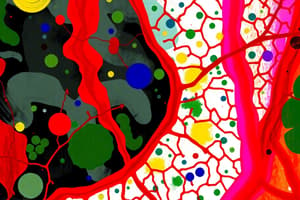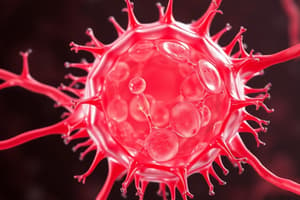Podcast
Questions and Answers
Which family of integral membrane protein mediates cell-cell adhesion by binding to carbohydrates on glycoproteins?
Which family of integral membrane protein mediates cell-cell adhesion by binding to carbohydrates on glycoproteins?
- Selectins (correct)
- Immunoglobulin superfamily
- Cadherins
- Integrin family
Which type of cell-cell junctions are found in epithelia?
Which type of cell-cell junctions are found in epithelia?
- Tight junctions
- Gap junctions
- All of the above
- Adherens junctions and desmosomes (correct)
Which signaling system occurs when a cell produces and responds to its own signaling molecules?
Which signaling system occurs when a cell produces and responds to its own signaling molecules?
- None of the above
- Endocrine
- Paracrine
- Autocrine (correct)
Which family of integral membrane protein mediates adhesion between nonimmune cells?
Which family of integral membrane protein mediates adhesion between nonimmune cells?
Which type of cell-cell junctions seal the extracellular space and make epithelial layers impermeable?
Which type of cell-cell junctions seal the extracellular space and make epithelial layers impermeable?
Which signaling system occurs when a cell produces signaling molecules that affect nearby cells?
Which signaling system occurs when a cell produces signaling molecules that affect nearby cells?
What converts information carried by extracellular messenger molecules into cellular responses?
What converts information carried by extracellular messenger molecules into cellular responses?
Flashcards are hidden until you start studying
Study Notes
- Four families of integral membrane protein mediate cell-cell adhesion: selectins, immunoglobulin superfamily, integrin family, and cadherins.
- Selectins bind to carbohydrates on glycoproteins from other cells and have a small cytoplasmic segment, a single membrane spanning domain, and a large extracellular portion.
- Immunoglobulin superfamily mediates adhesion between nonimmune cells and the Ig domains of one CAM binds to opposing CAM.
- Cadherins mediate cell-cell adhesion, and each type mediates cell-type specific adhesion and typically join cells of similar type to one another.
- Adherens junctions and desmosomes are types of cell-cell junctions found in epithelia.
- Tight junctions seal the extracellular space and make epithelial layers impermeable.
- Gap junctions permit intercellular communication through molecular “pipelines” between cells.
- Extracellular signals can take several forms, including small chemicals and mechanical stimuli.
- Three types of signaling systems are autocrine, paracrine, and endocrine.
- Signaling pathways consist of a series of proteins that ultimately alter cell activity, and signal transduction converts information carried by extracellular messenger molecules into cellular responses.
Studying That Suits You
Use AI to generate personalized quizzes and flashcards to suit your learning preferences.




